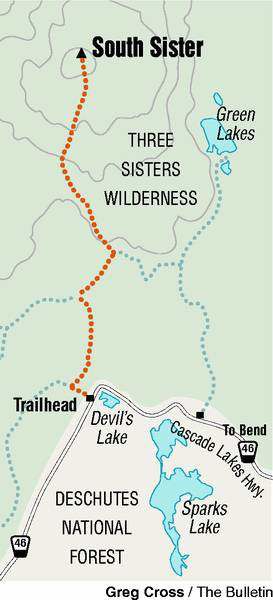South Sister
Published 5:00 am Friday, August 24, 2007

- South Sister
You’d think the best part about climbing a mountain like South Sister would be getting to the top and having a look around.
While the view is pinch-yourself gorgeous (and at 10,358 feet, breathtaking is another superlative that comes to mind), it’s the things that happen while getting to the top and back down again that make it so memorable.
Trending
Let’s face it. Gaining 5,000 feet in elevation in five miles is a bit of a burn (OK, for most of us it’s a muscle-busting combination of pain mixed with a bunch more pain). But doing the thing makes reaching the peak that much sweeter.
It’s the girl sitting cross-legged on a rock playing a flute, the joke shared between hiking partners midway up a steep scree-clogged slope with the wind whipping, the fellow from Los Angeles who got more than he’d bargained for on a honeymoon swing through Central Oregon.
You meet the most interesting people at 9,000 feet on what climber/author Jeff Smoot calls the “most-climbed glaciated peak in North America.”
I met the guy from L.A. a couple thousand feet from the top. His new brother-in-law had suggested that he and his bride stop in Bend to climb South Sister.
There at 8,500 feet taking a breather, he allowed he’d never done this kind of thing before and likely wouldn’t again. But a couple of hours later, there he was up top undoubtedly relieved (to be halfway done) and probably marveling at some inner grit he never knew he had.
The South Sister Climbers’ Trail begins at Devil’s Lake, winds up through a mixed pine and fir forest, over an open sub-Alpine mesa and then up to a false summit a good place to rest up for the final push.
Trending
That last mile to the summit, what Smoot calls “the mother of all cinder ridges,” is a precipitous slope of loose pumice with Lewis Glacier to the right.
With dozens of climbers strung along the slope from bottom to top, it reminded me of that famous photo of the Alaska goldminers trudging up the Chilkoot Pass.
According to local wilderness expert Les Joslin, South Sister is the youngest, least glaciated and tallest of the Three Sisters. It’s Oregon’s third highest peak behind Mount Hood and Mount Jefferson.
And, says Joslin, unlike Middle and North, South Sister, which began to erupt about 100,000 years ago, is primed to blow sometime again (We hope not on a summer weekend).
The reason climbing South Sister is so popular is that it doesn’t require special equipment or expertise. It’s what mountaineers call a walk up, which is why so many people climb South Sister. Some of whom would be better off tackling something more benign.
“I’ve seen for many years people going up there improperly prepared,” said Deschutes National Forest trails chief Chris Sabo. “You’re climbing up a volcanic peak two miles high in elevation. Conditions can be quite different up there, and they can change rapidly.”
Sabo advises climbers pack extra clothing (“the temperature can drop like a rock”), food and lots of water, say three or four quarts for the day. And, above all, use common sense. If a storm turns the upper mountain nasty, turn around.
— Jim Witty








